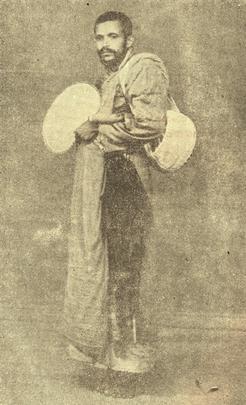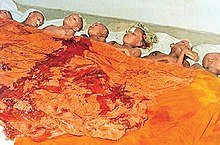
The Sri Lankan Civil War was a civil war fought in Sri Lanka from 1983 to 2009. Beginning on 23 July 1983, it was an intermittent insurgency against the government by the Liberation Tigers of Tamil Eelam led by Velupillai Prabhakaran. The LTTE fought to create an independent Tamil state called Tamil Eelam in the north-east of the island, due to the continuous discrimination and violent persecution against Sri Lankan Tamils by the Sinhalese-dominated Sri Lanka government.

The Special Task Force (STF) (Sinhala: විශේෂ කාර්ය බලකාය Visesha Karya Balakaya; Tamil: சிறப்பு அதிரடிப் படை) is an elite police tactical unit of the Sri Lanka Police specialising in clandestine and covert operations, combat and patrolling in urban areas, combat search and rescue, counterinsurgency and counterterrorism operations, crowd control, executive protection, forward observer, hostage rescue, indirect fire, irregular warfare, jungle and mountain warfare, parachuting, psychological warfare, search and rescue people who are in distress or imminent danger from disaster. serving high-risk arrest and search warrants, special reconnaissance, support military operations, tactical emergency medical, tracking, and unconventional tactics. It was formed in 1983 not as a military force, but rather as a highly specialised armed police unit.

Jaya Sri Maha Bodhi is a historical sacred bo tree in the Mahamewuna Garden in historical city of Anuradhapura, Sri Lanka. This is believed to be a tree grown from a cutting of the southern branch from the historical sacred bo tree, Sri Maha Bodhi, which was destroyed during the time of Emperor Ashoka the Great, at Buddha Gaya in India, under which Siddhartha Gautama (Buddha) attained Enlightenment. The Buddhist nun Sangamitta Maha Theri, a daughter of Indian Emperor Ashoka, in 236 BC, brought the tree cutting to Sri Lanka during the reign of Sinhalese King Devanampiya Tissa.[1] At more than 2,300 years old, it is the oldest living human-planted tree in the world with a known planting date. The Mahavamsa, or the great chronicle of the Sinhalese, provides an elaborate account of the establishment of the Jaya Siri Maha Bodhi on the Island and the subsequent development of the site as a major Buddhist pilgrimage site.
Human rights in Sri Lanka provides for fundamental rights in the country. The Sri Lanka Constitution states that every person is entitled to freedom of thought, conscience and religion, including the freedom to have or to adopt a religion or belief of his choice. And, that every person is equal before the law.
The Pottuvil Massacre was the killing of 10 Muslim labourers who had gone to repair the bund of Rattal Tank in Pottuvil in the southern part of the Ampara District on 17 September 2006. The victims were all men aged between 18–35 whose bodies were found hacked to death the next morning. The massacre was widely believed to have been carried out by the Special Task Force (STF).
The Anuradhapura massacre occurred in Sri Lanka in 1985 and was carried out by the Liberation Tigers of Tamil Eelam. This was the largest massacre of Sinhalese civilians by the LTTE to date; it was also the first major operation carried out by the LTTE outside a Tamil majority area. Initially, EROS claimed responsibility for the massacre, but it later retracted the statement, and joined the PLOTE in denouncing the incident. The groups later accused the LTTE for the attack. Since then, no Tamil militant group has admitted to committing the massacre. However, state intelligence discovered that the operation was ordered by the LTTE's leader Velupillai Prabhakaran. He assigned the massacre to the LTTE Mannar commander Victor and it was executed by Victor's subordinate Anthony Kaththiar. The LTTE claimed the attack was in revenge of the 1985 Valvettiturai massacre, where the Sri Lanka Army killed 70 Tamil civilians in Prabhakaran's hometown. In 1988, the LTTE claimed that the massacre was planned and executed under the guidance of Indian intelligence agency, RAW.
Operation Definite Victory was a military operation launched by Sri Lankan Special Task Force commandos on January 4, 2007 to liberate the Kanchikudichcharu and Thoppigala regions of the Ampara District of Sri Lanka from the LTTE. The army had accused the LTTE of carrying out the child abductions in Bakmitiyawa and Ampara, including the abduction of two teachers and 23 Tamil children in December by LTTE cadres when they were returning from extra classes to their homes.
Eelam War I is the name given to the initial phase of the armed conflict between the government of Sri Lanka and the LTTE.
Eelam War III is the name given to the third phase of armed conflict between the Sri Lankan military and the separatist Liberation Tigers of Tamil Eelam (LTTE).

The Eastern Theatre of Eelam War IV started in the Eastern province of Sri Lanka on July 21, 2006 when the LTTE cut off the water supply to rice fields in eastern Trincomalee district. The government claimed total control of the Eastern province after capturing Thoppigala on July 11, 2007, after nearly a year of fighting. Major battles took place at Sampoor, Vakarai, Kanchikudicharu, Kokkadichloai and Thoppigala. Military and civilian deaths were relatively low on both sides. Government forces captured much military hardware from the LTTE during the conflict. The civilians managed to flee the combat zones, and this reduced civilian casualties, while swelling the number of internally displaced people (IDP). The world health organization (WHO) estimated ~200,300 IDPs, and claims that significant progress occurred in resettling them. The LTTE vowed to attack Sri Lanka's military and economic targets across the country to retaliate for the capture of the Eastern province from them. This was stated by the leader of the LTTE's political wing, S.P. Thamilchelvan, in a statement to Associated Press on July 12, 2007.

Matara Kithalagama Sri Seelalankara Thera, also known as Dimbulagala Hamuduruwo, was a 20th century Sri Lankan Buddhist monk. He was a pioneer in restoring the ancient Buddhist monastery Dimbulagala Raja Maha Vihara in the 1950s and was the chief incumbent of the monastery for almost four decades.
Terrorism in Sri Lanka has been a highly destructive phenomenon during the periods of the Sri Lankan Civil War (1983–2009) and the first and second JVP insurrections. A common definition of terrorism is the systematic use or threatened use of violence to intimidate a population or government for political, religious, or ideological goals. Sri Lanka is a country that has experienced some of the worst known acts of modern terrorism, such as suicide bombings, massacres of civilians and assassination of political and social leaders, that posed a significant threat to the society, economy and development of the country. The Prevention of Terrorism Act of 1978 is the legislation, that provides the powers to law enforcement officers to deal with issues related to terrorism in Sri Lanka. It was first enacted as a temporary law in 1979 under the presidency of J. R. Jayewardene, and later made permanent in 1982.
The Aluth Oya massacre was the massacre of 127 Sinhalese civilians, including children and women, by the cadres of Liberation Tigers of Tamil Eelam organization on April 17, 1987, near the village of Aluth Oya, on the Habarana Trincomalee road in North Central Province of Sri Lanka. This massacre is considered one of the most notorious and devastating atrocities committed by the LTTE during the history of the Sri Lankan Civil War.

The 1987 Eastern Province massacres were a series of massacres of the Sinhalese population in the Eastern Province of Sri Lanka by Tamil mobs and Liberation Tigers of Tamil Eelam (LTTE) during the Sri Lankan Civil War. Though they began spontaneously, they became more organized, with the LTTE leading the violence. Over 200 Sinhalese were killed by mob and militant violence, and over 20,000 fled the Eastern Province. The violence has been described as having had the appearance of a pogrom.
The Battle of Pulukunawa took place during the Sri Lankan Civil War. It occurred on 11 December 1996 in which the LTTE militants attacked and overran the Special Task Force detachment at Pulukunawa in Ampara.






